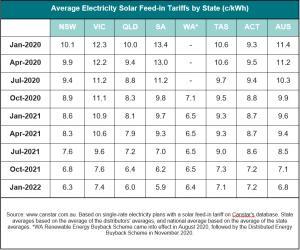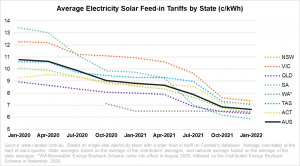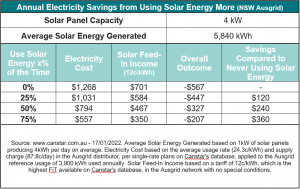New Canstar Blue research found that Aussies with solar panels could be saving up to $1,642 a year on electricity costs when compared to customers without solar, despite declining feed-in tariffs.
Unsurprisingly, the findings – which are based on an average household in Sydney – reveal bigger savings for residents with larger solar systems who are less reliant on the grid.
The research shows that a smaller 2 kilowatt (kW) system could save bill-payers $590 on yearly power costs, while Sydneysiders with a larger 4kW and 8kW system could slash $941 and $1,642 off their annual energy bills, respectively.
These savings are calculated by using a specific electricity usage rate, daily supply charge and solar feed-in tariff, for residents on the Ausgrid network who use solar energy 50 per cent of the time.
Despite these potential savings, many Aussies have questioned the value of solar as feed-in tariffs continue to drop. A solar feed-in tariff is the rate customers get paid from their energy retailer for exporting electricity back into the grid.
Given the average price of a 4kW system in Australia is $4,958 (according to recent data), it is understandable why some consumers aren’t completely sold on solar, Canstar Blue’s Energy Editor Jared Mullane explained.
“The upfront costs of installing solar can be extremely nerve-wracking, yet with generous yearly savings on offer – as shown in our research – a system can pay itself off quicker than you’d think,” he said.
“For a 4kW system saving $941 a year when compared to a home without solar, we’re only talking about a payback period of roughly five years.”
To figure out how much savings customers could expect with solar, they’d need to consider a range of personal factors, such as their budget, energy consumption needs, as well as the positioning of their roof, Mr Mullane added.
“The most obvious benefit of solar is to reduce household energy costs, but each house is different to the next which is why it’s best to contact a licenced installer and talk through your options. Most solar installers offer a free quote and consultation, and this is where you should be asking about the benefits a system could add to your home.”
A recent Canstar Blue survey revealed that 96 per cent of Australians installed solar as a long-term commitment to saving money on their energy bills, while more than a third of respondents (36%) did so to increase the value of their home.
Advertisement
How can customers with solar make the most savings?
For each kilowatt hour (kWh) of electricity that a household’s solar system exports to the power grid, that property will receive a feed-in tariff (FiT) of a few cents, usually between five and 16 cents per kWh. Feed-in tariffs are not paid out cash in hand, rather they apply as a deduction on household energy bills.
Solar feed-in-tariffs have been decreasing in recent years (as represented in the table and graph below), which means a higher feed-in tariff may help drastically reduce what customers pay for electricity. That is, though, if they are exporting enough leftover solar energy back into the grid.
How much have solar feed-in tariffs dropped by?
This table lists the average FiT by each state and territory from January 2020 to now.

As outlined in the table above and the graph below, feed-in tariffs have dropped significantly in the past two years.

During the early 2000s, higher feed-in tariffs were offered by power companies as a way of incentivising solar. There was also an abundance of state-based rebates that helped accelerate rooftop solar uptake to residents and businesses.
With solar now installed in three million homes across Australia, there are issues of supply and demand, as more solar-generated energy is pumped back into the grid. While this has led to falling wholesale prices and lower electricity costs for consumers, it has also driven down feed-in tariffs.
Regardless, two thirds of Aussies (66%) were aware of feed-in tariffs dipping before they installed their current system.
Compare Solar Energy Plans
Here are some of the cheapest solar-specific deals from the retailers on our database. These costs are based on the Ausgrid network in Sydney but prices will vary depending on your circumstances. We show one product per retailer, listed in order of lowest price first. Annual price estimates assume general energy usage of 3900kWh/year for a residential customer on a single rate tariff. Price estimates exclude solar feed-in tariff credits. These are products from referral partners†. Our database may not cover all deals in your area, and please check retailer websites for up to date information.
Here are some of the cheapest solar-specific deals from the retailers on our database. These costs are based on the Citipower network in Melbourne but prices will vary depending on your circumstances. We show one product per retailer, listed in order of lowest price first. Annual price estimates assume general energy usage of 4000kWh/year for a residential customer on a single rate tariff. Price estimates exclude solar feed-in tariff credits. These are products from referral partners†. Our database may not cover all deals in your area, and please check retailer websites for up to date information.
Here are some of the cheapest solar-specific deals from the retailers on our database. These costs are based on the Energex network in Brisbane but prices will vary depending on your circumstances. We show one product per retailer, listed in order of lowest price first. Annual price estimates assume general energy usage of 4600kWh/year for a residential customer on a single rate tariff. Price estimates exclude solar feed-in tariff credits. These are products from referral partners†. Our database may not cover all deals in your area, and please check retailer websites for up to date information.
Here are some of the cheapest solar-specific deals from the retailers on our database. These costs are based on SA Power network in Adelaide but prices will vary depending on your circumstances. We show one product per retailer, listed in order of lowest price first. Annual price estimates assume general energy usage of 4000kWh/year for a residential customer on a single rate tariff. Price estimates exclude solar feed-in tariff credits. These are products from referral partners†. Our database may not cover all deals in your area, and please check retailer websites for up to date information.
Image credit: simez78/Shutterstock.com
Savings per solar system size & by using more solar energy
| Annual Electricity Savings from Different Capacity Solar Panels (NSW Ausgrid) | |||||
| Solar Panel Capacity | Average Solar Energy Generated (kWh) | If solar energy is used 50% of the time… | |||
| Electricity Cost | Solar Feed-In Income (12c/kWh) | Overall Outcome | Savings Compared to No Solar Panels | ||
| None | 0 | $1,268 | $0 | -$1,268 | – |
| 2 kW | 2,920 | $794 | $116 | -$678 | $590 |
| 4 kW | 5,840 | $794 | $467 | -$327 | $941 |
| 6 kW | 8,760 | $794 | $817 | $23 | $1,291 |
| 8 kW | 11,680 | $794 | $1,168 | $374 | $1,642 |
|
Source: www.canstar.com.au – 17/01/2022. Average Solar Energy Generated based on 1kW of solar panels producing 4kWh per day on average. Electricity Cost based on the average usage rate (24.3c/kWh) and supply charge (87.8c/day) in the Ausgrid distributor, per single-rate plans on Canstar’s database, applied to the Ausgrid reference usage of 3,900 kWh used annually. Solar Feed-In Income based on a tariff of 12c/kWh, which is the highest FiT available on Canstar’s database, in the Ausgrid network with no special conditions. |
|||||
Annual electricity savings from using solar energy more (NSW, Ausgrid)



Share this article